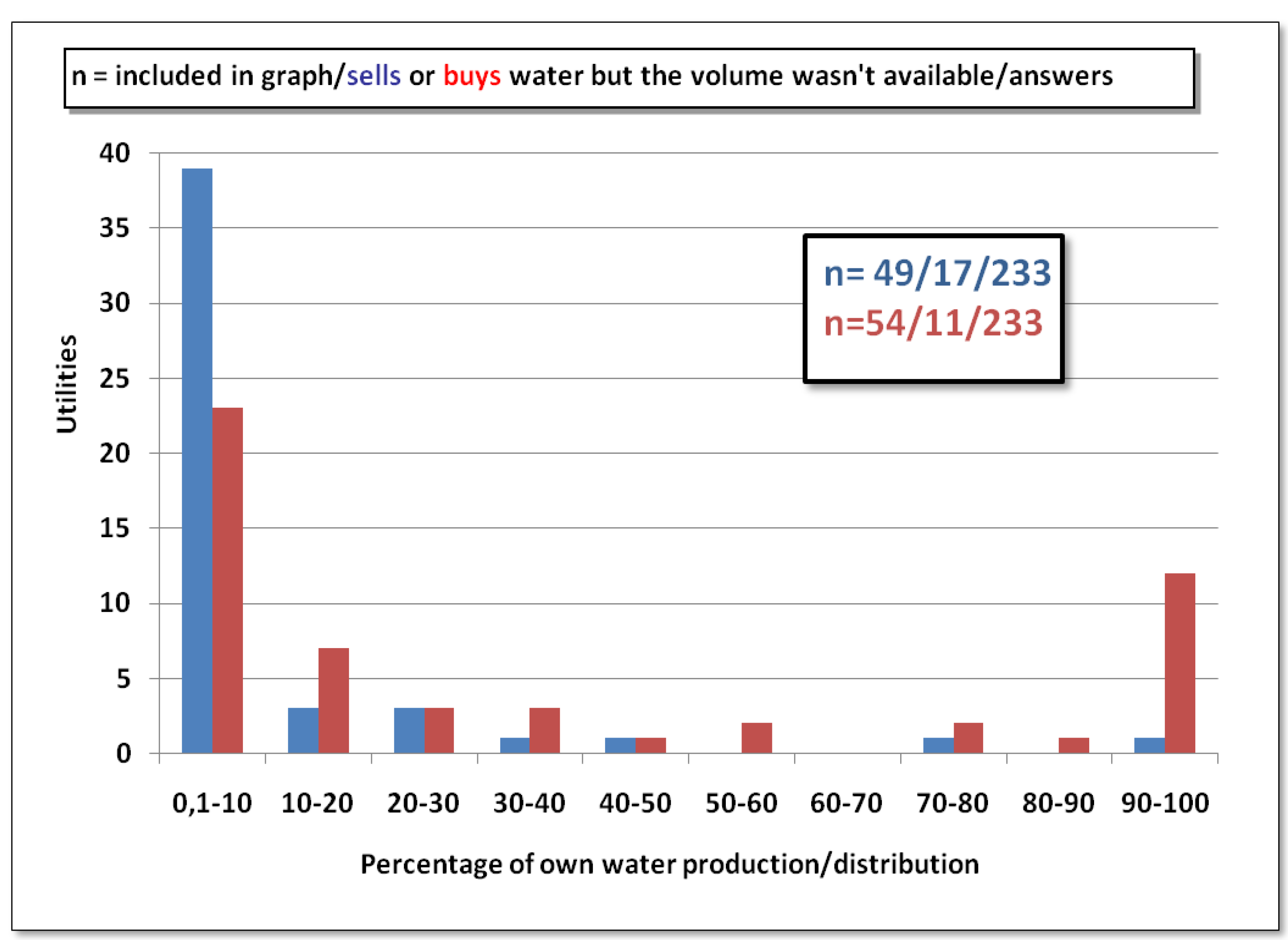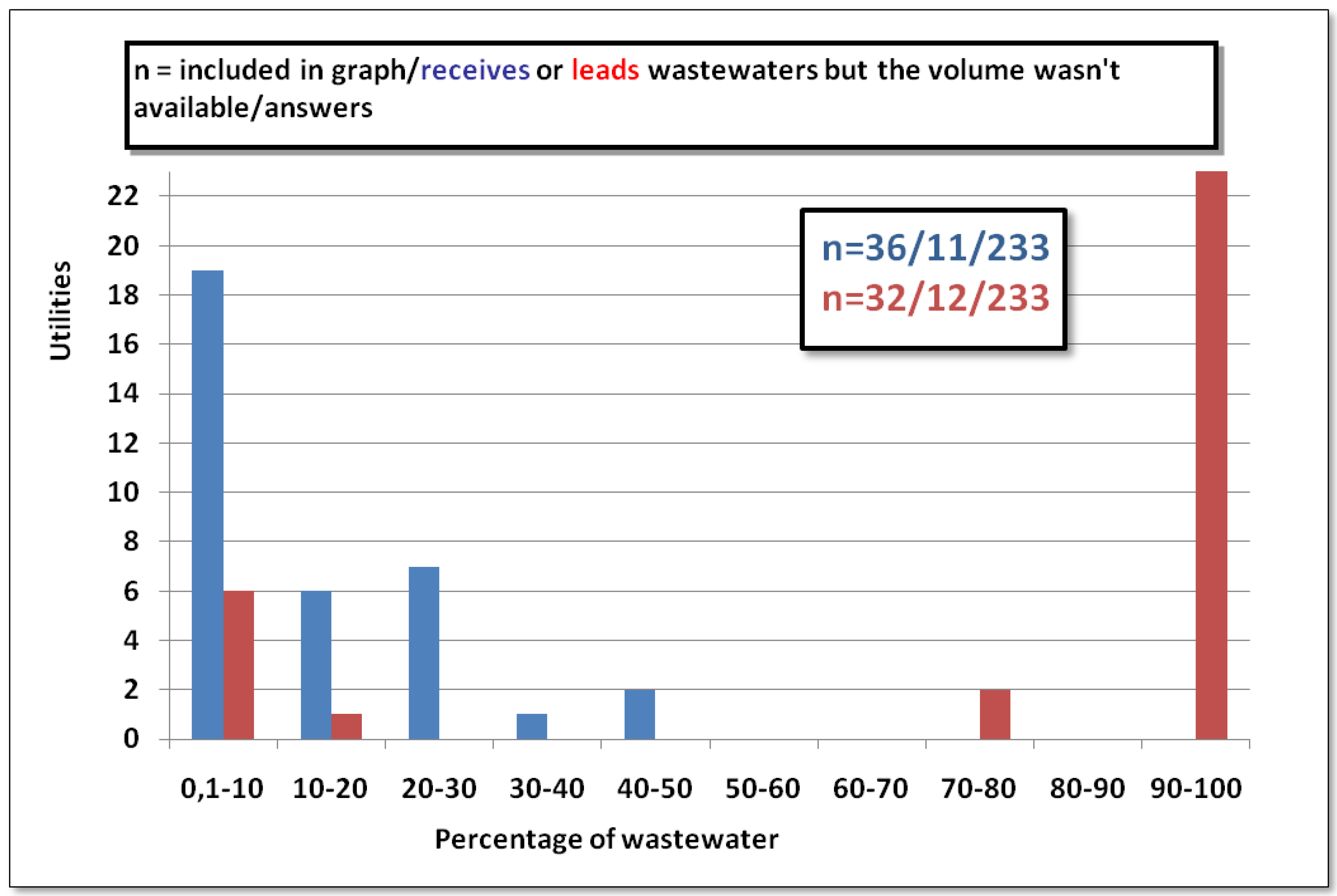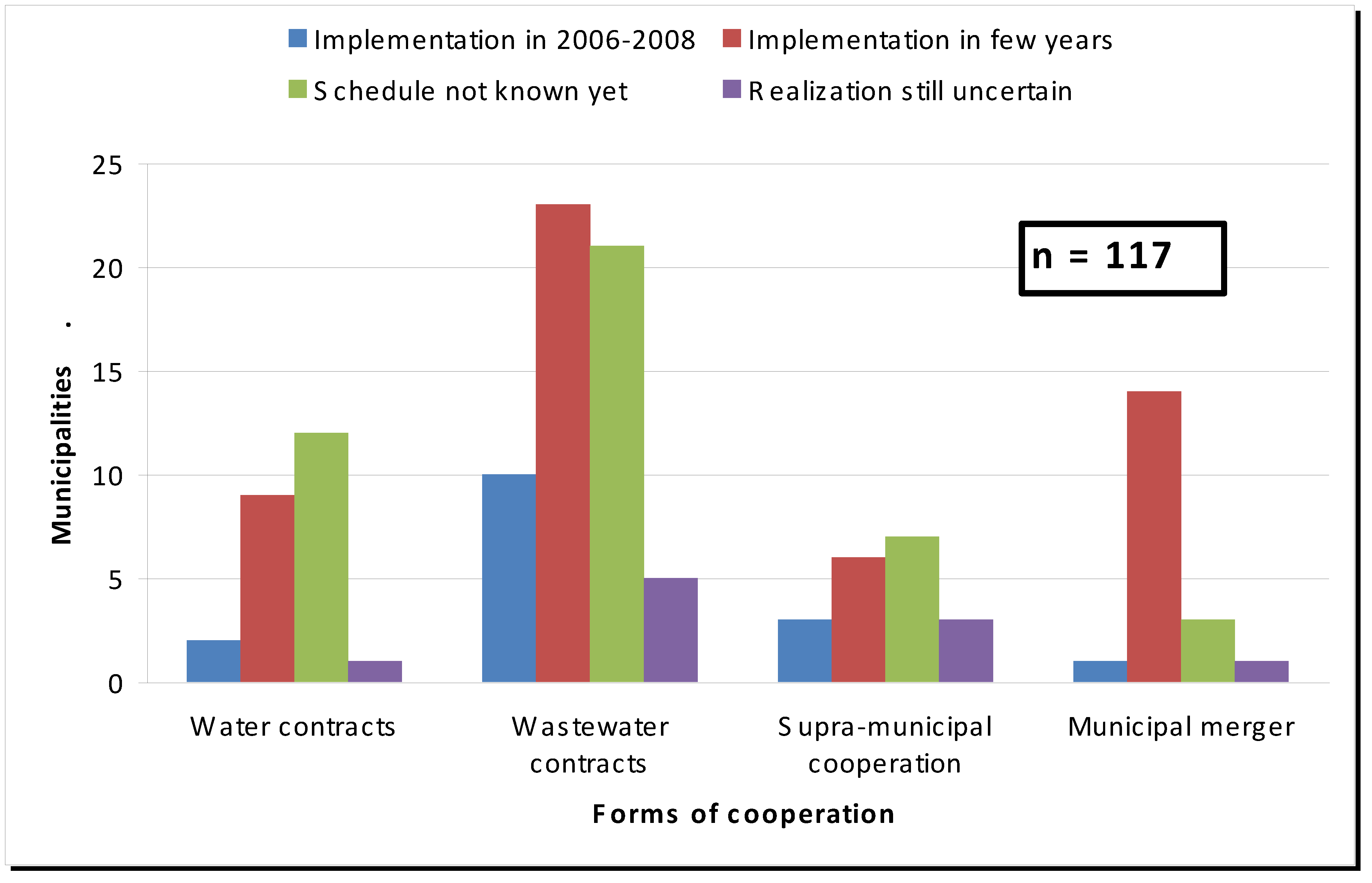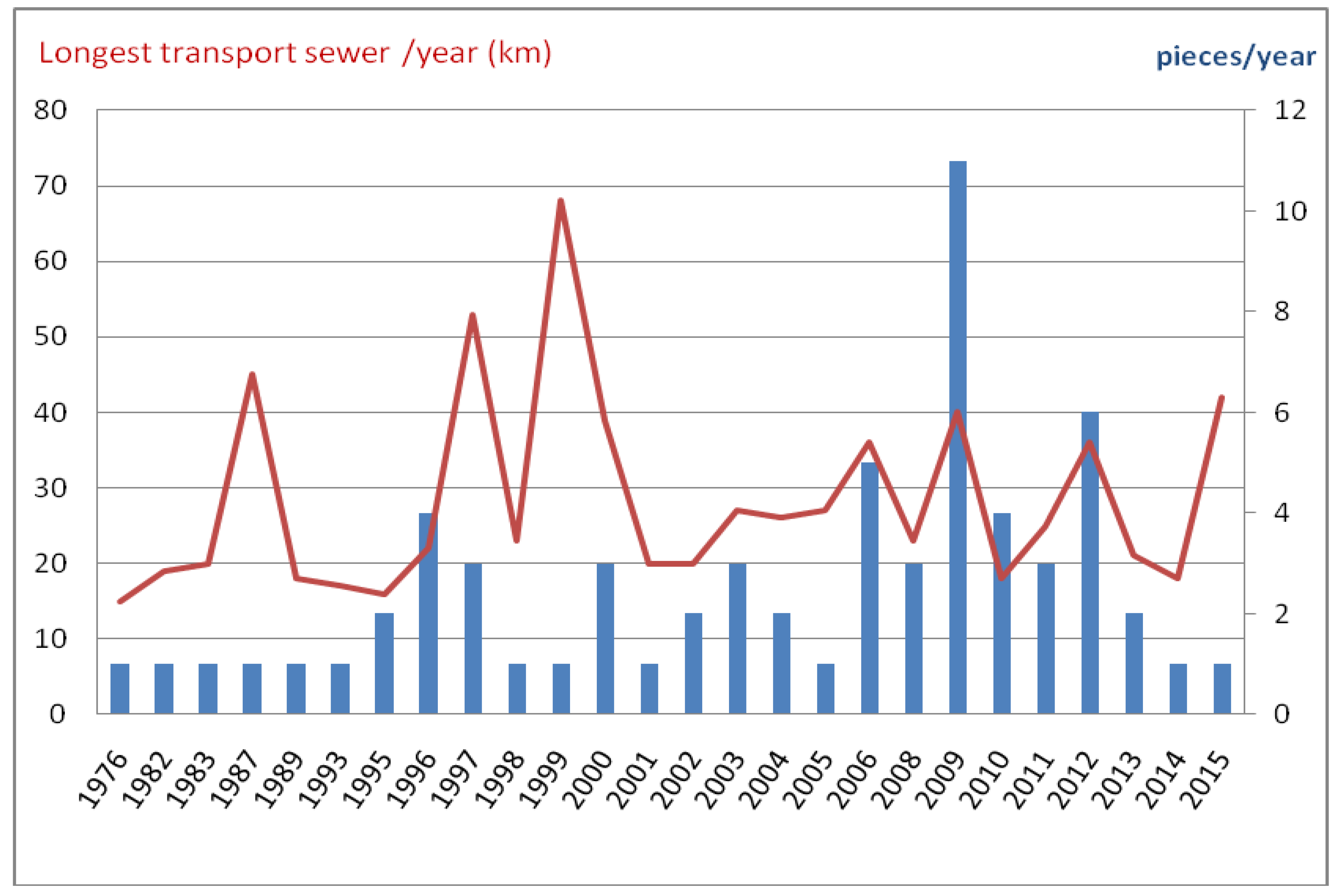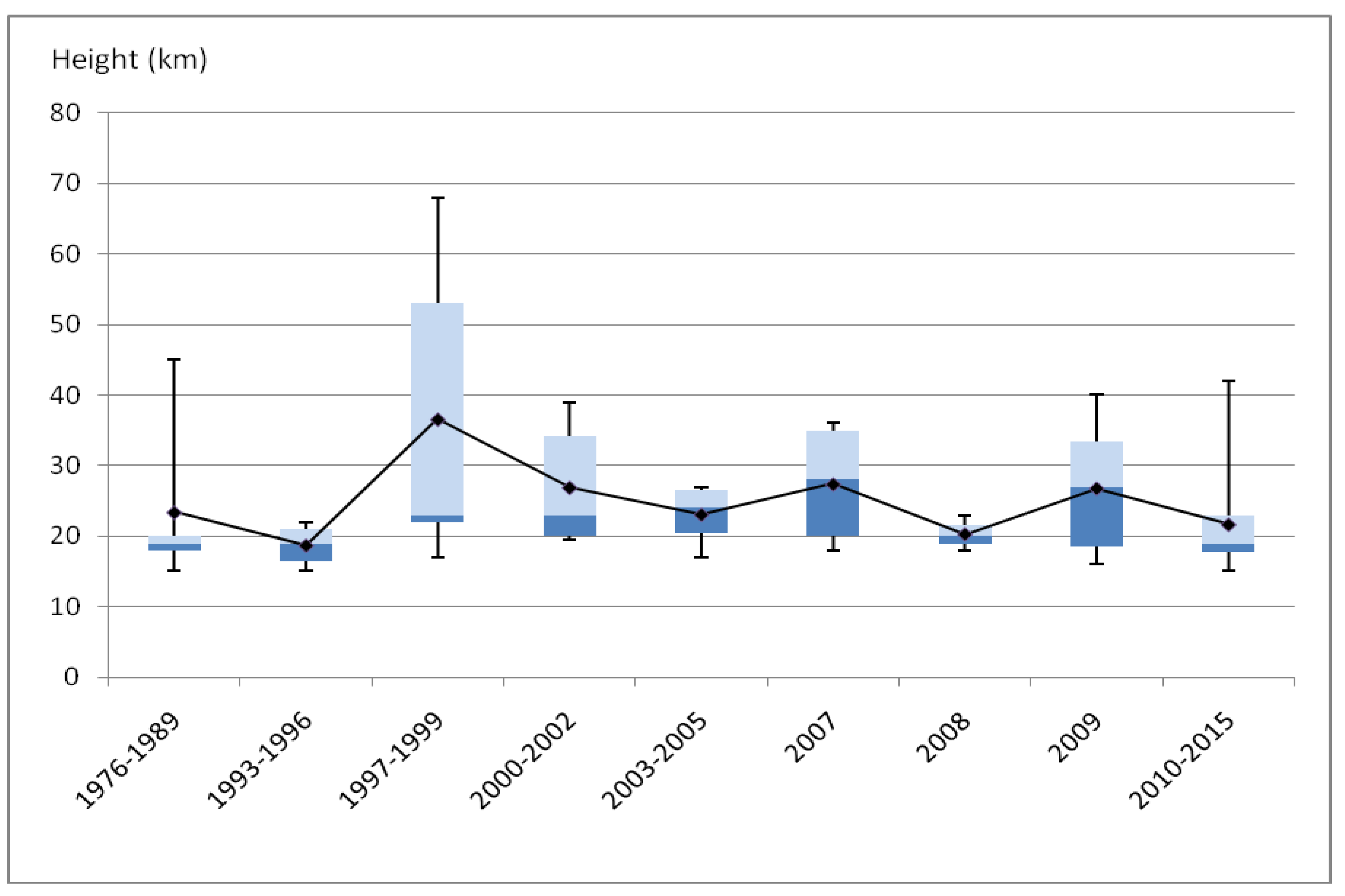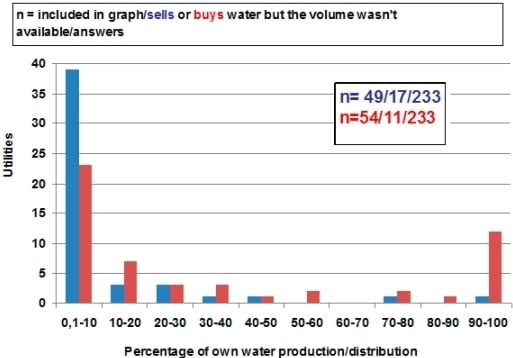1. Background
In Finland, water supply and wastewater services are managed at four major levels: supra-municipal, city and community, small rural systems, and private on-site systems. Supra-municipal cooperation can be divided into two major categories: cooperation based on established joint organizations such as companies or regional authorities, and cooperation based on bilateral contracts. The first type of cooperation can take place under the framework of a company or a municipal regional authority that provides all the services of several municipalities, operating on wholesale basis, or performing all the operations in the service area. Inter-municipal collaboration can also be based on bilateral contractual cooperation, the focus of this paper.
In international comparison, Finnish water and sewage utilities are small—as is the nation, with 5.3 million people in an area of 337,000 km
2. About 90 percent of the population is covered by public water supply systems and nearly 80 percent by public sewerage. Due to long distances and the abundance of water, the coverage of public water services in the country’s sparsely populated areas is rather low compared to many other European countries. However, the share of citizens served by public water services has continuously increased in Finland and is currently close to 100 percent in densely populated areas [
1].
Finland, like other Nordic countries, has a decentralized tradition of governance where local governments play a very important role in services. Municipalities have traditionally been responsible for arranging the services which may have been produced in different ways. Recently, the central government has started providing economic incentives to encourage municipal mergers.
Finland has gone through several periods of extensive municipal mergers in 1944–1947, 1966–1977 and 2000–2010. In 1944 the number of municipalities was 603, which by 1947 decreased to 547, by 1977 to 464, and finally to 342 in 2010 [
2]. These mergers affected the way water and wastewater services are managed. Water and sewage utilities, for their part, have also promoted other types of supra-municipal collaboration.
Based on the above, we will now look into the bilateral collaboration between neighboring municipalities. The other, tighter forms of collaboration will be discussed in a future paper [
3].
2. Objectives and Research Questions
The purpose of this paper is to explore and analyze bilateral contractual cooperation in water and wastewater services in Finland: its extent, evolution, operational experiences, contents of contracts and core principles. The study aims to provide research-based quantitative and qualitative knowledge and understanding covering the period from 1975 to 2006.
The study explores the following research questions: (i) prevalence of bilateral contracts between neighboring municipalities in Finland in the 1970s and 2000s, (ii) functioning of bilateral contractual cooperation and the key contents of contracts, (iii) expansion of contract-based collaboration in wastewater services in urban areas, (iv) links between bilateral neighbor collaboration and other forms of supra-municipal collaboration, (v) impacts of mergers of municipalities on supra-municipal collaboration [
4]. An additional justification for the study was that no national statistics on these systems are available.
3. Methods and Approaches
The original survey included three major phases and methods: a literature survey, an e-mail questionnaire sent to water and sewage utilities complemented by telephone calls, as well as interviews targeting nine case utilities. The last one aimed at analyzing in more detail the contents of and experiences from bilateral contracts. The results concerning the situation in 2006 were compared with those of the previous study from 1975 [
5].
The questionnaire was sent in January 2008 to 264 utilities that were members of the Finnish Water and Waste Water Works Association. Of the recipients, 24% replied. Those that did not were contacted by telephone—in some cases several times. This increased the response rate to 88%. Those that replied included, i.e., the 50 biggest municipalities in the country. The questions focused on qualitative issues related to bilateral contracts between municipalities.
Of the nine case utilities, eight were analyzed via telephone by semi-structured theme interviews—one preferred to reply by e-mail. The cases were selected so as to cover different types of contracts and to resemble the cases explored in the 1975 study to the extent possible.
The empirical data gathered primarily by interviews were analyzed by the contents analysis method. This method, based on the qualitative research tradition, is loosely defined and should rather be called a theoretical framework than a method. The aim was to describe the phenomenon in compact and common form. [
6] First, the empirical data were broken down, analyzed and reclassified into new categories. The material was explored by specifying, seeking out differences and similarities, and condensing. This way, the resulting description could be connected to the wider context and results. The functioning and applicability of bilateral contractual cooperation to water and wastewater services as well as the impact of adopting tighter forms of cooperation in bilateral collaboration were also assessed by SWOT (Strengths, Weaknesses, Opportunities, Threats) analysis.
One special aspect of the study was to explore the development and centralization of wastewater treatment plants. The data on 102 cities explored up until 1994 [
7] was updated and compared with data until 2009. Comparisons were made considering the municipal mergers since 1994 and without mergers. The centralization of wastewater treatment was also assessed by determining the length of the longest transfer sewers within regional environmental centers—those constructed since 1975 and planned for implementation by 2015.
4. Evolution of Bilateral Contracts
Inter-municipal contractual cooperation between water and wastewater utilities has been practiced in Finland since the late 1950s. Bilateral contracts dominate in supra-municipal cooperation. Their number has increased significantly in the last decades and is likely to do so also in future.
The first water sales contract was signed in 1959 between Espoo and Kauniainen, close to Helsinki. A little later, in 1961, Helsinki began to receive wastewater from Vantaa based on a contract. There are many reasons for such cooperation: the need for high quality raw water, the condition of the receiving water bodies as well as economic factors. Changes in the operating environment and municipal mergers also promote the centralization of water and sewerage services.
The number of bilateral contracts has tripled in the past three decades as shown in
Table 1. In 1975 there were 89 such contracts (the number of utilities taking part to the inquiry: n = 291) while in 2006 they numbered 288 (n = 233). According to the study, the number of contracts seems to be increasing especially in wastewater management.
Table 1.
Number of bilateral contracts in 1975 and 2006 and planned ones [
4].
Table 1.
Number of bilateral contracts in 1975 and 2006 and planned ones [4].
| Purpose of contract | 1975 (n = 291) | 2006 (n = 233) | Planned |
|---|
| Selling/buying of water | 39 | 138 | 24 |
| Temporary | 10 | 68 | |
| Common water intake plant | 7 | 1 | 0 |
| Wastewater treatment | 33 | 81 | 59 |
| Total | 89 | 288 | 83 |
It is common for bigger cities and utilities to make bilateral contracts with several utilities. One utility may enter into as many as 10 bilateral contracts. It is worth noting that the percentage of bought raw water is either very low or very high. The share of wastewater with other municipalities is also either very low or very high. (
Figure 1 and
Figure 2)
Figure 1.
Percentage of water sold to or bought from other municipalities in 2006 [
4].
Figure 1.
Percentage of water sold to or bought from other municipalities in 2006 [
4].
Figure 2.
Percentage of wastewater received from or transferred to other municipalities [
4].
Figure 2.
Percentage of wastewater received from or transferred to other municipalities [
4].
4.1. Operational Experiences
The operational experiences from bilateral collaboration studied by SWOT analysis are summarized in
Table 2. The content of bilateral contracts between utilities may vary a lot. Some of them are very specific while others are rather general. The key concern is determination of a fair level of payments; which also causes most problems.
Once in a while, it is argued in national policy discussions—though not necessarily in written form—that bilateral contractual cooperation is difficult. Yet, according to the study, contractual cooperation proved to be rather easy and smooth.
It was found that successful bilateral cooperation requires transparency and publicity as well as tailor-made and flexible contracts that can be changed when deemed necessary. One of the most essential and difficult aspects of contractual cooperation is the discussion of all the details and to reach agreements on them in order to be able to finalize the agreement. Success in this phase usually guarantees fruitful and fluent future cooperation (
Table 2).
In six out of the nine interviewed utilities, plans had been made for a tighter form of collaboration in the future. Several reasons were given for such plans: use of combined resources, reorganization of municipal boundaries, expected tariff adjustments, and better management of risks. One of the interviewees pointed out that municipal boundaries can be artificial and make management of water and wastewater services more difficult.
Several reasons for not planning a tighter form of collaboration were also presented. In some cases partners were not ready for cooperation or did not want it at all. Some were still waiting for a municipal merger to take place before making any bigger changes in their water and wastewater services. Some interviewees considered the merging of utilities an excessive measure. Reduced local knowledge and less municipal self-governance were also mentioned as weaknesses.
On the whole, tighter contractual collaboration would bring benefits and drawbacks which are highly case-specific. From the nine cases, it appears that there is much interest for tighter forms of collaboration but most hope that the process is slow and stepwise.
Table 2.
SWOT analysis of the functioning of bilateral collaboration [
4].
Table 2.
SWOT analysis of the functioning of bilateral collaboration [4].
| Strengths | Weaknesses |
|---|
| Easy | Payments and paper work |
| No need for separate organization | Large number of contracts |
| Open operational behavior | Conflicts before final agreement |
| Service provider takes care of problems | Lack of common organization |
| Adequate information | Unfair distribution of costs |
| | Administrative dispersion |
| Opportunities | Threats |
| Municipal self-governance remains | Difficult to change the contract |
| Contracts are easy to cancel/change | Inadequate contract |
| Transparency | Contracts are not honored |
| Contracts are carefully drawn | |
| Contracts are honored | |
4.2. The Future of Contractual Cooperation
It seems that both contractual and closer forms of cooperation will increase in the future. Of the 233 utilities, 117 had plans for some kind of future supra-municipal cooperation. Many of these plans (59) involved wastewater contracts (
Figure 3).
Contractual cooperation is usually the first step to closer supra-municipal cooperation. Of the future plans, 17 were related to closer forms of cooperation: 10 regional water supply and wastewater companies, three regional solid waste companies, two wholesale water supply companies, and one municipal authority were under planning. Twenty-one planned municipal mergers were revealed (
Figure 3). This can have a major impact on water and sewerage services. Municipal mergers can lead to larger units and thereby promote the centralization of water and wastewater utilities.
Figure 3.
Implemented and planned bilateral contracts between water and wastewater utilities in 2008 [
4].
Figure 3.
Implemented and planned bilateral contracts between water and wastewater utilities in 2008 [
4].
5. Centralization of Wastewater Treatment in Finland
Wastewater treatment has become more and more centralized largely due to recent increased bilateral collaboration and construction of bigger wastewater treatment plants. The first wastewater treatment plants in Finland were constructed in 1910. Their number started to increase after World War II, especially in the 1960s and 1970s, after the Water Act (1962) and the Sewage Surcharge Act (1974) took effect. In 1980, the country already had 106 wastewater treatment plants (
Figure 4).
The number of WWT plants peaked at 121 in 1990. By 2009 it had fallen to 107. Municipal mergers during 2000–2010 expanded the operational areas of wastewater utilities, thereby increasing the total number of WWT plants to 154 (
Figure 4).
In many cases small plants have often been gradually closed and transfer sewers constructed to bigger plants. As WWT requirements have been tightened in Finland, small WWT plants have often decided to direct their wastewater to larger WWT plants. This development has also been promoted by recent government policies. The conventional wisdom is that the bigger a plant is, the more reliable it is which, however, is questionable from the vulnerability and environmental points of view if systems expand excessively.
The concentration process can take place either within a municipality or between municipalities, commonly based on bilateral contracts. The longest supra-municipal transfer sewers are over 40 km long—the Utajärvi-Oulu sewer line in northern Finland is the longest at 68 km (
Figure 5 and
Figure 6).
Figure 4.
Number of wastewater treatment plants in Finland in 1910–2009 [
4].
Figure 4.
Number of wastewater treatment plants in Finland in 1910–2009 [
4].
Figure 5.
Number of supra-municipal transfer sewers over 15 km constructed and the longest constructed each year [
4].
Figure 5.
Number of supra-municipal transfer sewers over 15 km constructed and the longest constructed each year [
4].
Figure 6.
Box-and-whisker plot of the longest transfer sewers in Finland in 1976–2015 [
4].
Figure 6.
Box-and-whisker plot of the longest transfer sewers in Finland in 1976–2015 [
4].
The period 2006–2009 particularly was a time of concentration and long transfer sewers. The increased length of supra-municipal transfer sewers as well as the decrease in the number of small WWT plants are both a good indication of the trend of centralization of wastewater treatment in Finland.
6. Discussion and Concluding Remarks
Various types of supra-municipal collaboration in the provision of water and wastewater services take place in Finland. Supra-municipal cooperation has been favored by the Finnish Government as part of the recent international drive to improve the efficiency of these systems and their operations. Bilateral collaboration between neighboring municipalities and utilities—the focus of this paper—is also linked to the current process of municipal mergers. In some cases, collaboration in water and wastewater services may also have promoted or preceded cooperation in other services or municipal mergers. Yet, it is interesting to note how strongly the central government is promoting such mergers when there is little evidence of the assumed benefits, which in any case are not automatic.
This paper concentrates on the quantitative analysis of bilateral collaboration and its development from 1975 to 2006. It also deals with the qualitative analysis of experiences from bilateral collaboration. In the case of wastewater treatment, the data show concentration to bigger plants. This policy is largely based on the idea that a larger scale allows use of better technologies. The bigger plants are also constructed in bedrock, which is undoubtedly an advantage due to the constant temperature in cold winters compared to surface plants. Yet, there are also findings that even small and medium size wastewater treatment plants can operate economically if they have motivated and skillful operators [
8]. Thus, even the assumed sensibility of concentration of wastewater treatment is not certain in all cases. The overall feasibility of wastewater treatment concentration from the political, economic, social, technological, environmental and legislative points of view should be explored further.
The following conclusions were drawn concerning the bilateral collaboration in water and wastewater services between Finnish municipalities:
- (i)
Supra-municipal cooperation in water and sewerage services—particularly that based on bilateral contracts—has increased a lot in the last decades in Finland. The number of water buying/sales and wastewater transfer/receiving for treatment contracts between neighboring municipalities has tripled during the last three decades.
- (ii)
Contrary to common arguments, contractual cooperation proved rather easy to manage and should be seen as a serious option for other tighter forms of supra-municipal cooperation that are also increasing.
- (iii)
Wastewater treatment has become increasingly centralized, recently largely due to increased bilateral collaboration and construction of bigger wastewater treatment plants. In spite of its advantages, concentration also has its feasibility limits.
- (iv)
As for policy, the study implies the feasibility and necessity of thinking and exploring all possible options based on local needs and conditions when developing supra-municipal collaboration. Bilateral contractual cooperation can be considered an initial step towards tighter forms of collaboration if the latter are considered too difficult or risky in the short term.
In any case, it is important to explore each case individually and after amassing experience and trust, to consider possible tighter forms of collaboration. Yet, in a country with large quite sparsely populated areas, it is obvious that it is not feasible to expand the systems endlessly.
